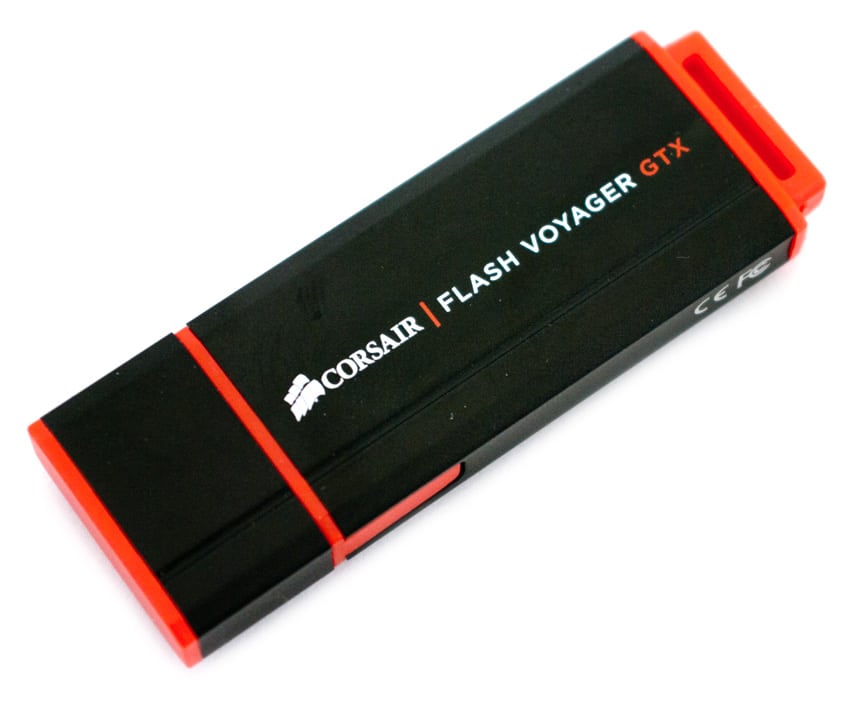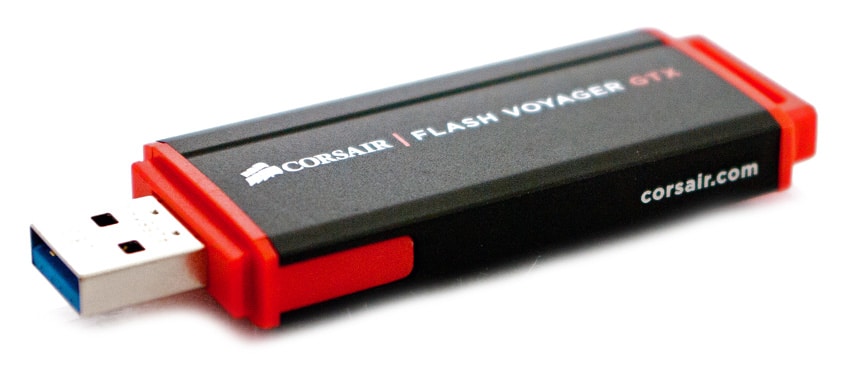
Corsair has recently released the Flash Voyager GTX flash drive, which is optimized for speed and hailed as their fastest USB drive yet (with reported transfer speeds approaching 450MB/s read and 350MB/s write). Corsair designed this flash drive for professionals in mind, but casual users too can revel in the high-speed transfer of large data collections like operating system images, game installs, video and music production projects, and large media libraries.

The Flash Voyager GTX makes use of SSD technologies like TRIM support to provide enhanced flash drive durability and ensure that users can continue writing to it for years despite heavy use. Voyager GTX is backed by a five-year warranty and carries a price of $119.99 and $239.99 for the 128GB and 256GB model, respectively. Our review is of the 128GB capacity.
Specifications
- Available capacity
- 128GB
- 256GB
- Performance/Speed
- Sequential Read
- 450MB/s and 430MB/s (ATTO and CDM, respectively)
- Sequential Write
- 350MB/s and 190MB/s (ATTO and CDM, respectively)
- Random 4K: 30kIOPS (read) and 5kIOPS (write)
- Sequential Read
- Operating System: Microsoft Windows, Mac OS X
- Compatibility: USB 3.0
- Weight: 0.03kg
- Warranty: 5 years
Design and Build
The Flash Voyager GTX has a standard capped USB drive design and is mostly black with red trimming and white branding in an aluminum chassis. It is wider than some other compact flash drives due to its 8 channel design (which is used to optimize speed).
The rear of the device has a rectangular recess that can be used to connect the flash drive to a keychain, but it is also formed so that the cap can be stored there during use (it just snaps on and off).
Performance
In this review, we include the following comparables from our database of recent USB flash drive reviews:
- Patriot Supersonic Magnum USB Flash Drive – 256GB
- SanDisk Extreme PRO USB 3.0 Flash Drive – 128GB
- Lexar JumpDrive P10 – 64GB
- Toshiba TransMemory Pro USB 3.0 Flash Drive – 128GB
Using our HP Z620 Workstation Testing Platform running Windows 8.1, we measured transfer speeds from the Corsair Flash Voyager GTX with IOMeter. Its sequential transfer speeds were measured to be 286.5MB/s and 63.47MB/s for read and write, respectively. It was the top performer in read activity, the next closest being the Patriot Supersonic Magnum which measured 275.8MB/s read and 149.3MB/s write. The SanDisk Extreme PRO was the top writing performer with 233.1MB/s read and 172.4MB/s write. The Toshiba TransMemory measured 216.1MB/s read and 123.3MB/s write while the Lexar JumpDrive P10 measured 220.7MB/s read and 133.2MB/s write.
When we switched to random large-block transfers the Flash Voyager GTX dominated in read performance with 282.9MB/s and was the second fastest in terms of write activity with 57.5MB/s, beaten out only by the SanDisk Extreme PRO which got 200.1MB/s read and 65.1MB/s write. The Toshiba TransMemory Pro was the slowest flash drive in read activity with 146.8MB/s and the second slowest in terms of write activity with 3.24MB/s. The Patriot Supersonic Magnum was the second-fastest flash drive in terms of read activity with 246.9MB/s but the slowest in terms of write activity with 1.76MB/s. The Lexar JumpDrive P10 was in the middle of the pack in both read and write, with 213.5MB/s and 11.9MB/s, respectively.
In our last flash drive benchmark which measures 4K random transfer performance in IOPS, the Flash Voyager GTX was the top performer in both read and write by far, achieving 6,711.4IOPS and 1,784.1IOPS, respectively. The next closest flash drive in read activity was the Lexar JumpDrive P10 with 4,645.8IOPS (30% slower than the Flash Voyager GTX) and the next closest in write activity was the SanDisk Extreme PRO with 479.9IOPS (75% slower than the Flash Voyager GTX). The Toshiba TransMemory PRO, SanDisk Extreme Pro and Patriot Supersonic Magnum scored 275.5IOPS, 1,493.4IOPS, and 2,013.8IOPS, respectively, in read operations. The Toshiba TransMemory PRO, Patriot Supersonic Magnum, and Lexar JumpDrive P10 showed write speeds of 5.02IOPS, 0.949IOPS, and 6.67IOPS, respectively.
Conclusion
The Flash Voyager GTX, Corsair's newest and fastest USB 3.0 flash drive to date, could satisfy the needs of just about anyone transferring of large data files like operating system images, games, and large media libraries; though clearly the performance of the drive slants more toward professionals. It is available in capacities of 128GB and 256GB carries a five year warranty.
Although its performance in our benchmarks fell short of Corsair's reported 450MB/s read and 350MB/s write, the Flash Voyager GTX still proved to be a very fast flash drive among the market's other top-end products. The Voyager GTX almost always found itself in the top two for read and write, usually battling with either the Patriot Supersonic Magnum or the SanDisk Extreme PRO. The Flash Voyager GTX was the top performer in sequential read, random read, and random 4K read and write.
Pros
- Excellent random 4k speeds
- Less expensive than many competing top-tier flash drives
- Big 256GB capacity
Cons
- Somewhat slow random write speed
- Wide design that doesn't fit in some USB ports
The Bottom Line
The Corsair Flash Voyager held its own against other top-spec flash drives and would be an excellent, lower-cost alternative for professionals and those who want high-speed access on the go to large sets of data.
Corsair Flash Voyager GTX at Amazon


